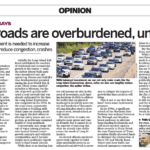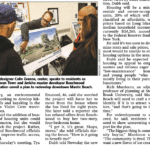The following was published in the November 25th edition of Long Island Business News. You can read the original here.
Not every Long Island downtown is destined to become the “next Patchogue” or the “next Mineola,” and it’s time for policymakers, developers, and elected officials to accept this very real fact.
As a region, we must adapt our real estate development strategies accordingly.
In a recent op-ed written for LIBN, Patrick Halpin, a former Suffolk County Executive who still is actively involved with local affairs, correctly asserted that that the LIRR is an asset – but his call to intensify development efforts around the Long Island Railroad’s 124 stations is off the mark.
The simple truth is that Long Island’s growth is constrained by environmental and infrastructural limitations. Between a federally-designated sole source aquifer that provides Long Islanders with drinking water, a marked lack of sewers in many of the communities where the LIRR’s stations are located, and the limited transit usage by commuters in Nassau and Suffolk Counties, the push to collectively pursue wholesale downtown redevelopment is troubling.
At a time when so many vested stakeholders in the development industry argue for loosening of local land use restrictions in Nassau and Suffolk Counties, it’s important to be reminded why exactly Long Island’s suburbia is what it is today. These calls to “build, build, build!” ignore the environmental necessity of curbing residential density – Many local zoning codes within Long Island’s unsewered areas were put in place to reduce harmful impacts on groundwater. Unless these areas can be sewered responsibly, growth should continue to be curbed.
There are some practical reasons why Long Island’s future shouldn’t be staked solely within the oft-touted downtown redevelopment model. Most Long Islanders don’t take the train, including those who can afford to live within supposed “smart growth” projects.
There is a marked disconnect between what the real estate industry is saying Nassau and Suffolk Counties need in terms of housing, what is being built, and how Long Islanders are actually living a supposed “transit-oriented” lifestyle.
According to a study conducted by the Suffolk County Department of Planning, around 8 percent of residents in transit-oriented projects actually take the train to work. This number is far less than one would expect after years hearing from Long Island’s development community how transit-oriented their projects are.
Overall, 88% of Suffolk’s workers drive to work, with only 10% or so of the workforce travelling the distance to New York City. In Nassau County, those numbers dip to 77% of commuters driving to work thanks to closer proximity to the City, and more readily available LIRR service to Manhattan.
Moving forward, developers need to incentivize transit use for residents, while municipalities offer some sort of bonus in unit yield for the reduction in automobile dependency. As projects like East Side Access and the LIRR double and third tracks are built, we need to find ways to take advantage of the increased transit access these projects will bring. We also need to both understand and address the drivers of cost in these smart growth projects, and explore why many rents in downtown areas exceed the typical cost of a mortgage on a single-family home.
Planning isn’t about the creation of blanket policies. Each of Long Island’s downtown areas has a unique fabric, complete with differing strengths and challenges that our redevelopment policies must adapt to. Yes, we should focus development within downtown areas – Long Island’s planners have called for this approach since the 1960’s – but it’s time we identify the areas where this model will be the most successful.
By calling for a wholesale increase in density, we’re planting the seeds not for a brighter future, but for one dominated by high-density suburban sprawl. Let’s be smart about our application of transit-oriented smart growth.
Murdocco regularly writes on Long Island’s land use and real estate development issues. More of his published work can be found on his website, www.TheFoggiestIdea.org, or follow him on Twitter @TheFoggiestIdea.
You can read the op-ed that inspired the piece here.












